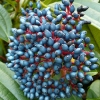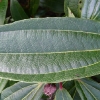Features
An evergreen shrub with long, leathery, dark green leaves which have three lengthways pleats dividing them. Heads of small white flowers appear in spring, followed by vibrant dark blue/black fruit in autumn and winter. Viburnum davidii is dioecious, so plants of both sexes are required to obtain fruits.
What to use it for
Good for the back of borders, particularly to provide colour early and late in the season, and as tall ground cover.
How to look after it
Top dress with organic matter annually to maintain the soil humus levels.
How to prune it
Prune in summer, after flowering. Cut stems back to strong shoots (or to the base) as required to keep the plant neat.
Male plants can be deadheaded as they will not produce fruit.
Mature plants respond well to hard pruning.
How to propagate it
Take semi-ripe nodal or internodal cuttings from midsummer to autumn, they should root in 6-8 weeks; use hormone rooting compound and gentle bottom heat to encourage rooting. Alternatively, hardwood cuttings can be taken in winter; take internodal cuttings which are about 6cm long and root them in rockwool. Bottom heat of around 12-20ºC and a humid environment will speed up the process.
Collect seeds when they are fresh (in autumn). Clean and sow them straight away in a warm place (warm stratification will cause them to germinate more quickly than cold stratification). Saved seeds should be sown in spring and will germinate the following year.
Common problems
Generally not affected by pests, but leaf spot diseases may be a problem.
If no berries are produced then this may be because you do not have a male and a female plant growing in sufficiently close proximity – this plant is dioecious and therefore requires both sexes to be present to produce fruit.
Other useful information
This plant was introduced to the west from China in 1904 and has received the Award of Garden Merit from the RHS.
The fruit can cause a mild stomach upset if eaten.









